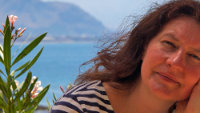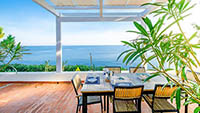Solunto: Relaxation and the past

So you're interested in holidays in Sicily. Ask yourself these three questions: Do you find looking at old stones boring and dull? The same for staring at signs full of historical information? Sick of tourist guides prattling on like schoolmarms?
If you answered yes, then the ancient city of Solunto is just right for you. No one knows why, but this tiny patch of earth has made a variety of cultures, ancient and modern, just feel - well, good.
And this is true even true in the wintertime. During the mild Sicilian winter, things are incredibly peaceful and calm in Solunto. The visitors who come marvel at the breathtaking panorama of the mountains and the sea while a few sheep here and there pine for spring. A more relaxing place is impossible to find.
Author

The information on this site comes from our Sicily expert Britta Bohn.
Britta has been dealing with daily life and life in Sicily for over 20 years.
Don't miss any of her tips! Subscribe to our free Newsletter:
An Invitation
Dear friends of Sicily, we invite you to join the Facebook Group "Trip-Tipp Sicily". Find answers to all your questions and discover exclusive tips for your trip to Sicily from those who have already made the journey and those who already know the island from the inside out:
Content
- Map for a trip to Solunto
- Solunto by bike and on foot
- Reaching Solunto by car by car
- Practical tips
- Food and drink
- Life in Solunto
- Solunto's spa
- Solunto's theater
- Solunto's commercial zone
- Solunto's forum
- Solunto's fitness center
- Solunto and science
- House of the Garlands
- Want to know more?
- Find your ideal holiday letting
Holidays lettings in Sicily

Are you looking for holiday lettings in Sicily but can't see the wood for the trees? We're not surprised, because the range of choices competing online is pretty confusing.
To make it simple, we present a small selection of quality holiday rentals, each one chosen for an unusual feature to make your holiday in Sicily extra special... more
Fashion made in Sicily

Sicilian fashion? Dolce & Gabbana?
Sure! But fashion designed and manufactured in Sicily is the real insider tip.
Like that of the Sicilian designer Filly Cusenza from Bagheria. She creates wearable art made of fabric, thread and buttons. Her trademark and label name is the fancy cartoon girl Filly Biz... more
The Essence of Sicily

Map for a trip to Solunto

- Parking lot
- Museum
- Tickets
- Thermal baths
- Gymnasion
- House of Leda
- Forum / Agorà
- Commercial zone
- Theater
- Public cistern
- House of the Garlands
- S. Flavia-Solunto-Porticello Train Station
- Bar Pizzeria 'Babilonia'
- Restaurant 'Tanit' - highly recommendable
- Bar 'Cafè Solunto'
- Fish restaurants along the harbor
- Bars and pizzerias close to the sea
- Bars and pizzerias at the village beach
- Casa Maria - 8 appartments
- B&B Flavilla
- Casa Colibrì - holiday apartment
- Maison Brigitte - holiday apartment
- Casa Panorama - Appartement
- Casa Chloé - 2 appartements
- Casa Enza - Appartement
- B&B Siciliò
Solunto by bike and on foot

If you rent one of the holiday apartments in Santa Flavia (purple Markers 1 through 6), you can reach Solunto either on foot or by bike. We recommend you use the route marked in green.
Tip: The final kilometer just before Solunto is pretty steep. It might make sense to hop off the bike and park it, making the rest of your way on foot.
Important note: a few short sections of the route in green involve going down a one-way street the wrong way. Please dismount and push your bike in these sections.
- Stay updated! Subscribe to our free Newsletter.
Reaching Solunto by car

The city of Solunto's foundations are so well preserved because the surrounding terrain is "unfavorable" for modern highways. However, for those on holiday in Sicily it works out quite well: the ancient city located only a few kilometers from the A19 motorway.
Nonetheless, the two nearby routes coming from Bagheria and Casteldaccia (see map above) are not recommended for holidaygoers in Sicily. These cut winding paths through the two cities, and it is very easy to get lost if you are not a local.
We recommend the Altavilla Milicia route. It leads directly onto state road SS113, and takes you nearly to the main parking lot in Solunto (Marker 2).
Solunto is also quite easy to reach for Sicily vacationers coming from the eastern end of the island. The A19 will bring you across the island if you are in Catania, or you can hop on the A20/E90 if you are coming from Messina.
- Stay updated! Subscribe to our free Newsletter.
Practical Tips

Solunto proper is an archaeological site that today is more for professionals than for tourists. There are no restaurants or souvenir shops as one might find elsewhere enjoying holidays in Sicily.
Luckily, the two villages below Solunto are full of friendly people happy to offer you food and drink, if not perhaps souvenirs.
We suggest you experience this place before the tourism companies discover what a jewel it is and start bringing in busloads of tourists. Just carry some things with you for creature comforts - maybe a small seat cushion to relax inside the ancient Solunto theater.
Panoramic photos of this site will give you a taste of what you will see in Solunto. These were taken in January 2017. You can see that during this mild time of the year, the photographer was almost alone - not counting the sheep.
Note: Please don't bring any tripods to Solunto. Filming and photography here are only allowed with cameras held in hand. The panoramas you see here were created using a "smuggled" tripod.
How to move through the panoramas:
- Click or tap on the green circle in the middle of the panorama to start the tour
- Move the panorama by dragging your mouse or finger up, down, right, or left
Food and drink

As we saw, Solunto is still just an exciting secret for tourists. The site offers no food and drink. But when it comes to the cities below it - Porticello and Santa Flavia - it's a different story.
Guests at the holiday apartments in Santa Flavia are already in the right spot. But anybody coming by Trenitalia can also enjoy. At the train station, for example, is a classic pizzeria with a bar (green Marker 2 on the map). And anybody who likes sweets should not shy away from the Celona bar (green Marker 3 on the map).
If you need a rental car, you should travel via Porticello (turquoise line on the map). You should be able to park near turquoise Marker 4. From there you can reach a variety of pizzerias and bars in just a few minutes on foot.
Note: Better to avoid going to the port directly (turquoise Marker 2). There are only a few parking places free.
- Stay updated! Subscribe to our free Newsletter.
Life in Solunto
Today in Solunto you see only what is left behind for those enjoying their holidays in Sicily. But for hundreds and hundreds of years, Solunto was a living, thriving place.
Life stopped in Solunto around the 3rd century when it fell into a peaceful, Sleeping Beauty-like sleep. And it was not until the 19th century that archaeologists 'woke it up'.
But why did the Romans give up such a beautiful spot? Maybe an earthquake was the reason. Except earthquakes are practically unknown in this part of Sicily. Landslides aren't likely either as Solunto is on the side of a small mountain.
The long slumber of Solunto may have been connected to another more fundamental problem in Sicily - water supply. Today the problem is dealt with using dams, and the ancient Romans used them as well. Just not in Sicily. Rainwater was collected instead in cisterns like this one (red Marker 10 on the map):

But what do you do when the cistern runs dry during the long, hot summer? Solunto, after all, sits on the side of a mountain, and in those days there were no pipelines or pumps or water trucks. When the well ran dry, it was probably time to move on.
- Stay updated! Subscribe to our free Newsletter.
Solunto's spa
If water was the reason why Solunto went to sleep for so many long years, it makes sense. Its inhabitants would have felt the lack of water very keenly.
For the ancient Romans, water was used for much more than drinking: it was a part of basic health and wellness. A certain Tiberius Claudius Secundus in Rome had this epitaph chiseled on his tombstone: "Sex, wine, and the baths wreck our bodies. But life is only sex, wine, and the baths."
Of course, the thermal baths in Solunto didn't quite compare with the giant baths in Rome. But the water was warm during the Sicilian winter. How it works is shown in the panorama (red Marker 4 on the map):

On the floor of the thermal baths, stones are piled to form small pillars. There was much more of this in the past. Previously, these pillars were close together and stood at regular intervals.
Upon these pillars craftsmen laid brickwork and even pavement - something that existed in ancient Rome. And they were even able to make it waterproof. Thus a basin with a hollow floor was built, and with the smoke rising from a large stove, they enjoyed warm baths in winter.
- Stay updated! Subscribe to our free Newsletter.
Solunto's theater
And what did a thoroughly-relaxed resident of Solunto do after a long bath at the spa? Go to the theater, of course.
One can see how important entertainment was in those days by the size of the theater. Compared to the rest of the city, it was huge.
Luckily, not much of the building behind the stage still stands. Luckily? Yes, because as result, today's visitors can sit in the theater and enjoy an incomparable view (red Marker 9 on the map):

In ancient times, this view was blocked for theatergoers, saving them from having to choose what was more interesting - the sea or the performance.
But these performances were not simply recitations from the ancient Greek philosophers. Had they been, maybe the sea would have been more fun to watch. No, like today there was a lot of comedy, and a lot of it was far from classical and polite: indeed, the motto might have been "sex, drugs, and rock and roll". After a long day at the spa, a little excitement was probably good.
- Stay updated! Subscribe to our free Newsletter.
Solunto's commercial zone
Partying in the evening is usually followed by work the next day (we hope this isn't true for those enjoying their holidays in Sicily). For many Solunto residents, this took place just above the beloved theater.
Today this area would be called a "commercial zone". If you are in Solunto, you will recognize it very quickly at the large red vase (red Marker 8 on the map):

Solunto's pottery was very popular across the region. How do we know this? Researchers from the University of Palermo figured out the chemical fingerprints of a variety of ancient pottery. And sure enough, the fine creations of Solunto's craftsmen seemed to make them world-champions when it came to the export of pottery.
Metalworking as well was big in Solunto. Though the ancients didn't understand why iron became hard in the forge, they used it anyway, producing impressive items for many centuries.
Ancient craftsmen were able to use very high temperatures. No surprise then they were familiar with another material that we think of as "modern" - glass. Though, of course, they also relied on materials that could be worked at lower temperatures like wood and wool.
Today Solunto is a place of rest and relaxation. But 2000 years ago, it was also full of the energy of commerce.
- Stay updated! Subscribe to our free Newsletter.
Solunto's forum
In early times, some level of basic craftsmanship was a part of day-to-day existence. But who can be a first-rate baker, potter, and blacksmith all at the same time?
The relatively high quality of life in Solunto meant that there was specialization. But then the question is: how did a hungry blacksmith get his hands on his well-earned bread?
For this to happen, there must be not only a baker, but money as well, and rules for how to spend and receive it. All this took place in antiquity around a central square.
The ancient Greeks called it the "agorà", and the Romans called it the "forum". Of course, to historians there were plenty of differences between the two. But for us normal people enjoying our holidays in Sicily, we make it easy. We just mark on the map where the town hall was and where the sheep are today (red Marker 7 on the map):

- Stay updated! Subscribe to our free Newsletter.
Solunto's fitness center
The fact that Solunto's residents were so fond of health and wellness as well as shallow entertainment shouldn't fool anyone. The ancient Greeks loved to make war, and they were always prepared.
War was at bottom one man's physical test against another man. This was true also when it came to sport and fitness. So the gym or fitness center is not a modern invention. The ancient Greeks called it a gymnasion. And here you can see what's left of the gym in Solunto (red Marker 5 one the map):

Over time, of course, the gym lost the sense of mortal combat, and the early "fitness center" became less about how to fight and more about how to stay in shape. Thus a word today in English which has no military connotations: "gymnastics".
And like so many other things, when the Romans got their hands on the idea, it changed from the early Greek model. The Romans even added a thermal bath, although unfortunately in Solunto, there is no sign of it here.
- Stay updated! Subscribe to our free Newsletter.
Solunto and science

The ancient Greeks had a wonderful variety of gods. But this did not stop them from also looking for scientific explanations for things.
As a matter of fact, the more historians learn about ancient times, the more astonishing their scientific progress looks. One of the world's top scientists at that time was even a Sicilian: Archimedes. He lived in Syracuse (not Solunto), but the science of the ancients left behind impressive and surprising traces almost everywhere you look.
On the floor of the House of Leda, archaeologists discovered a mosaic representing a map of the heavens (astrolabe). Here in the panorama, it is under the tiny roof (red Marker 6 on the map):

Today no one knows to whom the house belonged originally. It is called the House of Leda today because of the representation inside of Leda, the legendary woman seduced by Zeus who visited her in the form of a swan.
It's also unknown why someone would set an astrolabe into tiles. There wasn't much practical benefit. Of course, it wasn't a pure flight of artistic fancy. Even an early Picasso would not have depicted an astronomical instrument at random.
Was the house an early observatory? Did it belong to an early scientist like an Archimedes whose theories and discoveries are now lost to time? We will probably never know.
- Stay updated! Subscribe to our free Newsletter.
House of the Garlands
Solunto has another striking house. Archaeologists and historians have dubbed it the "House of the Garlands" because of a wall painting there. But only a trace of it remains. However, the view outside (red Marker 11 on the map) shows why so many enjoying their holidays in Sicily come to this spot:

It's a snow-white ground mosaic on the outskirts of the city. But it is anything but peripheral. Located next to the theater and the forum, it is only a short walk to the main public squares. And just to the side is a free unobstructed view of the Gulf of Termini Imerese.
The way to the public spa was a bit far though. Did the residents here have their own facilities? For the ancient "one percent" this was quite common. And the House of the Garlands certainly belonged to someone from the upper classes. Unfortunately, very little remains to tell us how they lived. But that's okay - we still have the panorama.
- Stay updated! Subscribe to our free Newsletter.
Want to know more?

Archaeologists and historians aren't satisfied with the beautiful panorama, however much it attracts those enjoying holidays in Sicily. They are always looking for more to tell us how the ancients lived.
And more has been discovered than you might expect. Many of these finds are located in the Solunto Museum and in the Antonino Salinas Archaeological Museum in Palermo.
If you want to dig into this material even more extensively, we recommend these books:
Alberto Sposito
(1) Solunto: Paesaggio, Citta, Architettura
L'Erma di Bretschneider
Alberto Sposito is considered one of the foremost experts on Solunto. His latest book gives an overview of the current state of archaeological research. Unfortunately, the book is only available in Italian and is very expensive.
Markus Wolf
(2) Die Agora von Solunt: Öffentliche Gebäude und öffentliche Räume des Hellenismus im griechischen Westen
(3) Die Häuser von Solunt und die hellenistische Wohnarchitektur
Reichert Verlag
Markus Wolf works for the Deutsche Archäologische Institut Rom. He recreates some of Solunto's most important buildings in his books (available in German).
- Stay updated! Subscribe to our free Newsletter.